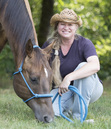Elena Hartwell's Blog, page 19
August 30, 2024
The Summer of Love and Death: A Ford Family Mystery
The Summer of Love and Death by Marcy McCreary [image error]
Guest Post + an Excerpt + Book & Author Info + a Giveaway!
Don’t miss any blog tour post! Click the link here.
The Summer of Life and Death
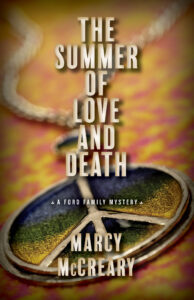 The summer of ’69: memorable for some, murder for others.
The summer of ’69: memorable for some, murder for others.
Detective Susan Ford and her new partner, Detective Jack Tomelli, are called to a crime scene at the local summer stock theater where they find the director of Murder on the Orient Express gruesomely murdered—naked, face caked in makeup, pillow at his feet, wrists and ankles bound by rope. When Susan describes the murder to her dad, retired detective Will Ford, he recognizes the MO of a 1969 serial killer . . . a case he worked fifty years ago.
Will remembers a lot of things about that summer—the Woodstock Festival, the Apollo 11 moon landing, the Miracle Mets—yet he is fuzzy on the details of the decades-old case. But when Susan and Jack discover the old case files, his memories start trickling back. And with each old and new clue, Susan, Jack, and Will must narrow down the pool of suspects before the killer strikes again.
Book Details:
Genre: Mystery (Detective)
Published by: CamCat Books
Publication Date: August 13, 2024
Number of Pages: 336
ISBN: 9780744310597 (ISBN10: 0744310598)
Series: A Ford Family Mystery, #3 | A Stand-Alone Series
To purchase The Summer of Love and Death, click any of the following links: Amazon | Barnes & Noble | BookShop.org | Goodreads | CamCat Books
Guest post from Marcy McCreary
How a Cover Concept Inspired a Story Element
Publishing a book has many thrilling and pinch-me moments, but I think one of my favorite moments is seeing the cover art concepts for the first time. That’s when things start getting real. Every publishing house is different. Sometimes authors get a say, sometimes they don’t. Luckily, my publisher, CamCat Books, encourages its authors to take part in the process.
To start the ball rolling, the art director sends me a “Cover Brief” to fill out. The first part is easy: a description of the book, a few pertinent details about the story that might impact the cover, the intended audience, the category/genre. Then comes the creative part . . . words that describe the tone of the book (what kind of mood should the cover evoke) and the emotion of the book’s message (what do I want my readers to feel when they look at the cover). I used words like mysterious, intriguing, cryptic, enigmatic, nostalgic.
The next section of the Brief asks what elements of the story should be echoed on the cover. A particular season? An era? A character? A prop? Because my story explores intergenerational trauma, is partly set in 1969, and involves a serial killer who ties up his victims with rope, I suggested imagery such as a DNA helix made of rope, a DNA helix in psychedelic or tie-dye colors, or a DNA helix wrapped around a peace sign. I proposed a dove perched on a rope, a sort of homage to the Woodstock Festival poster. I also suggested simply creating a cover with psychedelic patterns or tie-dyed colors with no objects. I was also asked what I didn’t want to see on the cover. The answer to that was easy: people. And that was simply because that element did not appear on the two earlier books in the series.
And lastly, I researched other books that were published in the last five years to find covers I liked and didn’t like to give the art director a point of reference as to what appealed to me and what I wanted to avoid.
Then comes the fun part. The art director sent me fifteen cover concepts to weigh in on. Turns out the DNA concept made the novels look like medical or sci-fi thrillers—so those didn’t quite work. I loved the tie-dyed covers—and there were several colors and patterns in the mix to choose from. But one cover stood out from the rest. On it, a stained glass peace-sign necklace. But I was hesitant in choosing it. Why? There was no stained glass peace-sign necklace in my story! I mean, sure, there’s a connection to 1969, but the dominance of the necklace on the cover made it seem like it was an integral part of the plot. And that got me thinking . . . was there a way to incorporate that necklace into the storyline?
As I mentioned earlier in this essay, intergenerational trauma—its detrimental and long-lasting effects—is a key theme explored in my novel, the notion of psychological and genetic baggage passed down from one generation to the next. What if the stained glass peace-sign necklace was a physical manifestation of intergenerational trauma, some unwanted thing passed down from one generation to the next. An unwelcome inheritance of sorts. Something that reminds you of a past you would rather forget. And once I got that seed of an idea, I figured out how to weave the stained glass peace-sign necklace into the storyline.
Read an excerpt of The Summer of Love and Death:
You know that jittery, gut-roiling feeling you get when heading out on a blind date? That brew of nerves, anxiety, anticipation—plus a hint of dread. That pretty much summed up my morning. Today was the day, and standing at the front door, it finally hit me. I was no longer flying solo. A new partner was waiting for me down at the station.
My fingers twitchy, I fumbled with the zipper of my yellow slicker as I stood in front of the framed poster—an illustration of a white dove perched on a blue guitar neck, gripped by ivory fingers against a bright red background—touting three days of peace and music. Usually, I paid it no mind. But today it captured my attention. A signal, perhaps, that everything would turn out just fine, like it did exactly fifty years ago when four hundred thousand idealistic hippies descended upon this town. A projected disaster that ended up being a glorious experience. The legendary summer of love.
The Woodstock Music and Art Fair didn’t take place in Woodstock, New York. The residents of Woodstock were not keen on having the initially projected fifty thousand hippies traipsing through their town. The concert promoters eventually secured Max Yasgur’s dairy farm in Bethel, New York—fifty-eight miles from Woodstock and six miles from where I live now. I was four at the time. I have no memory of it. Mom said I was sicker than sick that weekend. Ear infection. Fever escalating to 104 degrees. She tried to take me to a doctor, but the roads were clogged with festival revelers, so she had to postpone my appointment until Tuesday. But by then, the worst of it was over.
Fifty years. Those teenagers were in their sixties and seventies now. The older ones in their eighties. How many of them were still idealistic? How many were still into peace, love, and understanding? How many “dropped out” and berated “the man,” only later to find themselves the beneficiaries of capitalism? Becoming “the man.”
I leaned over slightly as I reached for the doorknob. The door swung open unexpectedly, smacking me in the forehead. “Whoa.” I ran my fingertips along my hairline. No bump. For now.
“Sorry, babe.” Ray’s voice drew Moxie’s attention. Our thirteen year-old lab mix moseyed into the foyer, tail in full swing. Moseying was really all Moxie could muster these days. “Didn’t realize you were standing there.”
Ray had left the house an hour earlier. I peered over his shoulder at the running Jeep. “Forget something?”
“Yeah. My wallet.” Ray stepped inside, dripping. Moxie stared up at him, waiting. He squatted and rubbed her ears. “Raining cats and dogs out there. No offense, Moxie.” He glanced up at the poster. “Just like fifty years ago.” He sighed.
Ray’s parents were married at the festival by a traveling minister. One-year-old Ray in tow (earning him bragging rights as one of the youngest people to attend Woodstock). Tomorrow would have been their fiftieth wedding anniversary. Their death, at the hand of a drunk driver twelve years ago, spawned a program called Better Mad Than Sad—a class baked into the local drivers-ed curriculum that Ray (and the drunk driver’s girlfriend, Marisa) created ten years ago. Parents would join their kids for a fifty-minute session in which they pledged to pick up their kids or their kid’s friends, no questions asked, no judgment passed.
Last month, Ray reached out to a few of his and his parents’ friends asking if they would be up for a “celebration of life” vigil at the Woodstock Festival site this evening. Nothing formal. Just twenty or so folks standing around, reminiscing and shooting the shit about his parents.
Ray shook the rain off his jacket. “Met your new partner this morning.”
“Yeah?”
“He’s very good-looking.” He smirked, then added, “Movie-star good looking.”
I leaned back and gave Ray the once-over. “I’m more into the rough-around-the-edges type.”
“So I got nothing to worry about?”
“Not as long as you treat me right.” I smiled coyly. I had been without an official partner for a little over a year, since July 2018. My ex-partner bought a small farm in Vermont. He told me not to take it personally, but he was on the verge of a nervous breakdown. I still wondered if I contributed to his anxiety in some small way. Then I got shot in the thigh that August. So hiring a new partner was put on hold. Upon my return to active duty in October of 2018, I was assigned an under-the-radar cold case with my dad brought on as consulting partner. By the time the Trudy Solomon case was resolved, in December 2018, Chief Eldridge still hadn’t found a suitable replacement. Small-town policing isn’t everyone’s cup of tea. So for the better part of 2019, it was just me and my shadow. Dad and Ray assisted on the Madison Garcia case, but the chief made it clear that protocol called for two detectives working a case, and my partnerless days were numbered. Don’t get me wrong. It’s not like I didn’t want a partner. I did. I just wished I had a say in who it was.
*** Excerpt from The Summer of Love and Death by Marcy McCreary. Copyright 2024 by Marcy McCreary. Reproduced with permission from Marcy McCreary. All rights reserved.
Marcy McCreary — Author of The Summer of Love and Death

Marcy McCreary is the author of the Ford Family Mystery series.
She graduated from George Washington University with a B.A. in American literature and political science and pursued a career in marketing and communications.
She lives in Hull, MA with her husband, Lew.
To learn more about Marcy, click on any of the following links: www.MarcyMcCreary.com, Goodreads, BookBub – @marcymccreary, Instagram – @marcymccrearyauthor, Threads – @marcymccrearyauthor, Twitter/X – @mcmarcy & Facebook – @marcymccrearywrites
Visit all the Stops on the Tour!
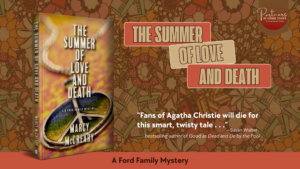
08/20 Interview @ Literary Gold
08/20 Showcase @ Mystery, Thrillers, and Suspense
08/21 Showcase @ Books, Ramblings, and Tea
08/21 Showcase @ Silvers Reviews
08/22 Review @ Pat Fayo reviews
08/23 Review @ Paws. Read. Repeat
08/24 Review @ Guatemala Paula Loves to Read
08/25 Guest post @ Binge Reading Books
08/26 Review @ Book Reviews From an Avid Reader
08/26 Review @ Country Mamas With Kids
08/27 Showcase @ fuonlyknew
08/28 Showcase @ 411 ON BOOKS, AUTHORS, AND PUBLISHING NEWS
08/29 Showcase @ Celticladys Reviews
08/30 Guest post @ The Mystery of Writing
09/05 Interview @ darciahelle
09/09 Review @ bookwormbecky1969
Elena Hartwell/Elena Taylor

The post The Summer of Love and Death: A Ford Family Mystery appeared first on The Mystery of Writing.
August 28, 2024
The Cadieux Murders: Cover Reveal
The Cadieux Murders, by R.J. Koreto

The ink is still wet on the contract, but Wren Fontaine is already running into trouble as she renovates Cadieux House, a modernist masterpiece on Long Island’s exclusive Gold Coast. The home’s architect was the brilliant and eccentric Marius Cadieux, her father’s mentor, and Ezra doesn’t want Wren to change as much as a doorknob.
And the home itself comes with a dark past: In 1955, it was the site of the never-solved murder of its owner, Dennis Blaine. Cadieux himself was alleged to be having an affair with Dennis’s wife, the stunningly beautiful Rebecca. It seems like yesterday’s headlines, but then someone starts killing people with a connection to the house.
The home’s new owner—bestselling novelist Bronwyn Merrick—may be using the house to launch a fictionalized account of the 1955 crime. But someone may not want to her to. Just how far will Bronwyn’s armed bodyguard go to protect her?
As Wren untangles the threads, she finds they all lead back to the house. Rebecca apparently inspired the strange, yet alluring residence, and both the home and its mistress may have caused uncontrolled emotions that led to tragedy. Wren uses all her architectural skills to decipher the hidden message Cadieux cunningly wove into the home’s design.
She must think back 20 years to when, as a little girl, she met Cadieux. Deeply impressed with Wren, he gave her a clue about the house—and his unusual friendship with Rebecca.
With her girlfriend Hadley at her side, Wren eventually solves the mysteries of the home and the people who lived there, develops a grudging respect for modernist architecture—and learns something about the difference between love and obsession.
To purchase The Cadieux Murders, click the following link: AmazonR.J. Koreto — Author of The Cadieux Murders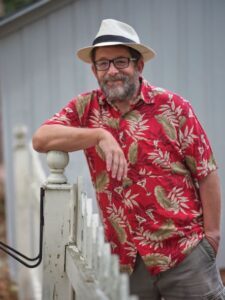 Over the years, R.J. Koreto has been a magazine writer, website manager, textbook editor, novelist and merchant seaman.
Over the years, R.J. Koreto has been a magazine writer, website manager, textbook editor, novelist and merchant seaman.
He was born and raised in New York City, graduated from Vassar College, and has wanted to be a writer since reading The Naked and the Dead. In addition to his novels, he has published short stories in Ellery Queen’s Mystery Magazine, Alfred Hitchcock’s Mystery Magazine, the 2020 Bouchercon Anthology and Paranoia Blues: Crime Fiction Inspired by the Songs of Paul Simon.
His current series features Wren Fontaine, an architect who finds mysteries in the historic homes she renovates. He and his wife have two grown daughters, and they divide their time between Rockland County, N.Y., and Martha’s Vineyard, Mass.
To learn more about R.J., click any of the following links: www.RJKoreto.com, Goodreads, BookBub – @rkoreto1, Instagram – @RJKoreto, Threads – @RJKoreto, Twitter/X – @RJKoreto & Facebook – @RJKoretoVisit all the Blog Tour Stops!

08/27 Books, Ramblings, and Tea
08/28 The Mystery of Writing
08/27 ashmanda. k
08/27 Celticladys Reviews
08/27 Guatemala Paula Loves to Read
08/27 Kenyan Poet
08/28 Silvers Reviews
08/27 Country Mamas With Kids
8/27 Binge Reading Books
08/27 Book Reviews From an Avid Reader
08/27 fuonlyknew

The post The Cadieux Murders: Cover Reveal appeared first on The Mystery of Writing.
August 27, 2024
The Mechanics of Memory: A Debut Mystery
The Mechanics of Memory by Audrey Lee
Author Interview + Book & Author Info + Author Pet Corner!Don’t miss any debut author interviews, click the link here for more.The Mechanics of Memory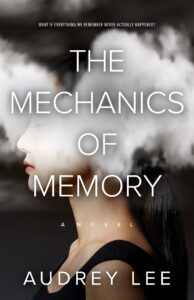 Never Forget.
Never Forget.
Memory is Copeland-Stark’s business. Yet after months of reconsolidation treatments at their sleek new flagship facility, Hope Nakano still has no idea what happened to her lost year, or the life she was just beginning to build with her one great love.
Each procedure surfaces fragmented clues which erode Hope’s trust in her own memories, especially the ones of Luke. As inconsistencies mount, her search for answers reveals a much larger secret Copeland-Stark is determined to protect.
But everyone has secrets, including Hope.
To purchase a copy of The Mechanics of Memory, click either of the following links: Amazon and CamCat.The Mechanics of Memory — Author Interview with Audrey LeeThe Mechanics of Memory centers on Hope Nakano. Tell us about her:
A year ago, Hope’s life revolved around desert sunsets, single malt scotch, waffles on Saturday mornings, and Luke.
Today, not so much. Her new life is about organic food, yoga, and sound baths at the Wilder Sanctuary in Rancho Mirage. Which might not be so terrible, if only she were allowed to leave. And if she could remember why she was there in the first place.
Hope is smart and tenacious, attributes that aren’t exactly an asset at Wilder. She wants desperately to get back to her old life, with Luke and his daughter Charlotte. But as memory fragments begin to surface, Hope begins to question if she truly wants to remember her past.
Many readers who know me have commented on how Hope and I share the same brand of snark. (I haven’t a clue what they’re talking about.)
The Mechanics of Memory is set at the Wilder Sanctuary in Rancho Mirage. What is that like, and how does the setting aid the tenseness of the storytelling?
The Wilder Sanctuary is an uber-posh detox facility that primarily caters to A-List celebrities and has a price tag to match. Residents at Wilder eat Michelin-star food, participate in yoga, meditate, and have a dedicated team of doctors focused on their wellness. However, there’s also a darker side to Wilder. Some residents are there for traumas which have caused memory loss and are receiving cutting-edge “therapies” to help them remember.
A definition of the word wilder is to perplex or bewilder, something I often thought about while creating this world. There are many real-life luxury detox places around the world—ones I will never make enough money to see—but I’ve always wondered if there is something sinister lurking just below the surface at those spas.
I loved creating a setting that is serene and sexy by design, because happy people don’t tend to question their situations. And since it’s a psychological thriller, I also wanted the reader to feel a claustrophobic tension between the sleek veneer of Wilder and the fact that no one can leave.
The Mechanics of Memory plays with memory, making the narrator unreliable. What drew you to that as a concept for your debut novel?
This all happened because I heard an interview on NPR with Dr. Julia Shaw and subsequently bought her book, The Memory Illusion. As I dove deeper, I was simultaneously fascinated and horrified at how unreliable our memories are.
Basically, our brains are like Swiss cheese: we have gaps in what we remember, and our minds fill in those gaps to make sense of the world. And we are highly susceptible to suggestion, to want to please and conform, and to our own confirmation biases. Dr. Shaw uses her powers for good, in trying to correct police interrogation processes and reveal how susceptible humans are to mind manipulation.
But the whole time, my mind kept returning to all the nefarious possibilities of that kind of power. So then I thought, you could do some pretty shady stuff with that ability.
And then, I started writing.
What was the biggest surprise publishing your debut?
This whole thing has been a wild ride with an enormous learning curve. I have loved every minute of it: signing with my agent and publisher, seeing my cover mocks, getting that Goodreads Author badge next to my name, reading my first five-star review from a complete stranger, receiving my shipment of my hardcovers.
One of the highlights of this journey was seeing my copyright page. (That’s the page in the front we never scrutinize but is always there in a book.) I actually squealed when I saw it. When it’s your own name and you see the words Library of Congress, it makes everything you’ve worked for feel legit.
When you’re not writing, you’re working in education. Tell us about that side of your career:
I’ve spent over two decades in education, first as an elementary teacher and then as an administrator.
Now I work as an educational consultant delivering professional learning to educational institutions around how to build systems for students that are more equitable, compassionate, and socially just.
I feel so lucky to get to do this, as it’s something I wholeheartedly believe in. (I’ve haven’t been able to say that at all points in my career!)
What are you working on now?
About six months ago, I finished the sequel to The Mechanics of Memory. But something wasn’t quite right about it, and so I shelved it so I could get some distance.
I recently just finished a standalone novel, currently titled One for Sorrow. It’s still a dark thriller/mystery, but with less technology and a dash of paranormal.
Words of Wisdom for Aspiring Writers:
Read a lot. Study reading as a writer.
Write every day. I had a writing professor in college who made us turn in a five-page essay every single day for an entire semester. His belief was that the only way you can become a better writer is to write, and it’s true. Keep at it until you finish, even when the imposter syndrome is telling you otherwise.
Write honestly. When you get that weird feeling in your stomach saying something doesn’t feel right or you’re being lazy, listen to it. Readers notice when you pull punches.
Remember that finishing your first draft is just the beginning. Pat yourself on the back, pop that champagne, and then buckle up … there’s a lot more work to be done.
Great advice!Author Pet Corner!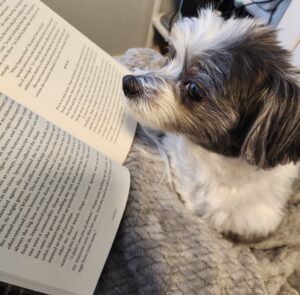 Luna! The Reader.
Luna! The Reader. Luna!
Luna!Luna is so cute, Elena decided she needed two photos!
Audrey Lee — Author of The Mechanics of Memory

Audrey Lee started writing fiction at the young age of eleven, when she and her best friend co-authored a masterpiece about gallivanting around London with the members of Depeche Mode, Wham!, and Duran Duran. Unfortunately, these spiral notebooks have yet to find a publisher evolved enough to understand the genius buried within.
As a result, The Mechanics of Memory is her first work of published fiction.
Before she started writing fiction, Audrey received her master’s degree in education from UC Berkeley (Go Bears!) and spent over two decades in public education. When she isn’t writing books she consults with school districts about creating environments for students that are more equitable, culturally responsive, and socially just.
Audrey lives in the San Francisco Bay Area with her husband, son, and Maltipoo, Luna.
When not working, Audrey is compulsively organizing something, bullet journaling, cheering for her son at a dance competition, max betting on a slot machine, or watching the Golden State Warriors with a dirty martini in hand.
To learn more about Audrey, click on any of the following links: Website, Facebook, Goodreads, Twitter, Instagram, and PinterestElena Hartwell/Elena TaylorThe post The Mechanics of Memory: A Debut Mystery appeared first on The Mystery of Writing.
August 22, 2024
Starlit Bookshop Mystery: In the Event of Murder
Starlit Bookshop Mystery: In the Event of Murder, by Cynthia Kuhn
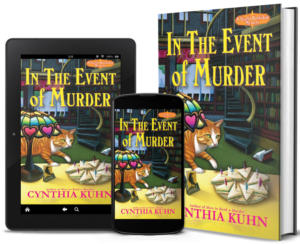
It’s the star-studded event of the season in Silvercrest, Colorado—but some of the guests might not make it to the last dance alive in the second charming installment of the Starlit Bookshop mysteries from Agatha Award-winning author Cynthia Kuhn.
Nestled on the banks of a breathtaking Rocky Mountain river and dotted with delightful boutiques and galleries, Silvercrest, Colorado, is a book lover’s paradise. Bookseller and literary event planner Emma Starrs is looking forward to attending the annual Silvercrest Library Gala, a glamorous evening with celebrities including the legendary Whitney Willton, currently on the hit crime show Chasers, and her niece, party-planner-to-the-stars Lyra Willton. Gala Week is full of exciting activities honoring both page and screen, and library board president Tabitha Baxter is basking in the glow of her successful launch—until Lyra is found dead.
With the gala only days away, the board asks Emma for help, despite Tabitha—her longstanding nemesis—bristling over the choice. Emma agrees, even though she is already in charge of a classic mystery panel at her family’s bookstore, Starlit Books, which turns out to have its own challenges. Meanwhile, Whitney, who is aware of Emma’s sleuthing skills, begs her to find the killer. The case grows more complex with the disappearance of several priceless objects, an attack on one of the attending celebrities, and other predicaments. Emma searches for clues while handling every unexpected twist and turn leading up to the extravagant affair. But when the guests step onto the red carpet, a killer still lurks in the shadows—and murder just might become the main event.
In the Event of Murder (A Starlit Bookshop Mystery)
Cozy Mystery
2nd in Series
Setting – Colorado
Publisher : Crooked Lane Books (August 20, 2024)
Hardcover : 304 pages
ISBN-10 : 1639100709
ISBN-13 : 978-1639100705
Welcome to your tour of Starlit Bookshop! My name is Emma Starrs, bookseller and literary event planner, and I’ll be your guide.
Starlit Bookshop is in a gray stone building on the main street of Silvercrest, Colorado, alongside a variety of shops and boutiques. The town is known for its artisan community, and you can find all kinds of unique gifts for anyone (including yourself) here.
The first thing you’ll notice about Starlit Bookshop is that the glass front is divided by a gorgeous stained glass window that has every color of the rainbow and a star for every member of our family who has worked here. My father, an artist like many of the folks in our little town, created it. The bookstore itself is a family affair: my grandparents founded it, then my parents Austen and Nina ran it, and now my sister Lucy and I—along with our aunt Nora—have taken over.
Indoors, there are rows and rows of books, with a ladder that runs along an iron track to retrieve them. You’re welcome to rest on any of the damask armchairs that are available here and there—or you may prefer to read at one of the tables in the back. Anne Shirley, our beloved cat, may even grace you with a visit.
When you’re ready, you can use the spiral staircase or the elevator to reach the second-level mezzanine, which has arched windows along the sides and many more books, of course. Note the glowing lights shaped like stars that hang from the ceiling—also handmade—we hope you find them as charming as we do! They lift our spirits every day, as do the framed pictures of authors behind the register.
Behind the store, we have a cozy nook of a porch with wrought iron furniture and tons of cushions. The river beside it burbles all day long. You couldn’t ask for a more peaceful spot! Please take in the spectacular view: the Rocky Mountains create a stunning backdrop for the river, as well as for the nearby wildflowers and trees.
Finally, we have appreciated our neighbors over the years but right now we may be in our Ultimate Era, with the best coffeehouse in the world—Riverside Coffee, owned by our friends Diandra and Ariadne—on one side and our friend Vivi’s Silver Blossom catering company on the other. We are literally surrounded by deliciousness.
Come see us again soon!
I would LOVE to come and visit! Thanks for spending time with me and my readers!Starlit Bookshop Mystery Author Cynthia Kuhn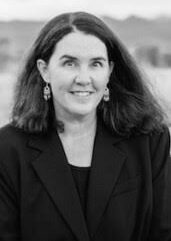 Cynthia Kuhn writes the Starlit Bookshop Mysteries, which focus on a bookseller solving crimes in an artistic mountain community, and the Lila Maclean Academic Mysteries, featuring a professor-turned-amateur-sleuth.
Cynthia Kuhn writes the Starlit Bookshop Mysteries, which focus on a bookseller solving crimes in an artistic mountain community, and the Lila Maclean Academic Mysteries, featuring a professor-turned-amateur-sleuth.
Her work has also appeared in Mystery Most Diabolical, Mystery Most Edible, McSweeney’s Quarterly Concern, Copper Nickel, Prick of the Spindle, Mama PhD, and other publications. For more information, please visit cynthiakuhn.net.
To learn more about Cynthia, click on any of the following links: Blog, Twitter/X, Website.Visit all the Stops on the Tour!
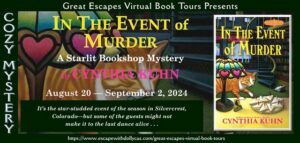
August 20 – Mystery, Thrillers, and Suspense – SPOTLIGHT
August 20 – Boys’ Mom Reads! – SPOTLIGHT
August 21 – Christy’s Cozy Corners – AUTHOR GUEST POST
August 21 – Literary Gold – SPOTLIGHT
August 22 – Books, Ramblings, and Tea – SPOTLIGHT
August 22 – The Mystery of Writing – CHARACTER GUEST POST
August 23 – Baroness Book Trove – SPOTLIGHT
August 23 – Sapphyria’s Book Reviews – REVIEW
August 24 – Socrates Book Reviews – SPOTLIGHT
August 24 – Lady Hawkeye – SPOTLIGHT
August 25 – FUONLYKNEW – SPOTLIGHT
August 26 – Cassidy’s Bookshelves – REVIEW
August 26 – fundinmental – SPOTLIGHT
August 27 – Ruff Drafts – AUTHOR GUEST POST
August 27 – Maureen’s Musings – SPOTLIGHT
August 28 – Rebecca M. Douglass, Author – REVIEW
August 28 – Reading Is My SuperPower – REVIEW
August 28 – Escape With Dollycas Into A Good Book – REVIEW
August 29 – StoreyBook Reviews – CHARACTER GUEST POST
August 29 – MJB Reviewers – SPOTLIGHT
August 30 – Sarah Can’t Stop Reading Books – REVIEW
August 30 – Celticlady’s Reviews – SPOTLIGHT
August 31 – Bigreadersite – REVIEW
August 31 – Jane Reads – CHARACTER INTERVIEW
September 1 – Cozy Up With Kathy – REVIEW
September 2 – Melina’s Book Blog – REVIEW
Elena Taylor/Elena Hartwell

The post Starlit Bookshop Mystery: In the Event of Murder appeared first on The Mystery of Writing.
August 20, 2024
A Fatal Feast at Bramsford Manor
A Fatal Feast at Bramsford Manor, a new cozy by Darci Hannah
Spotlight!Book & Author InformationFind other new-to-you authors and books! Click the link here for blog tour posts.A Fatal Feast at Bramsford Manor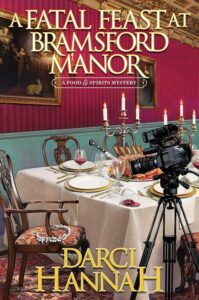 While filming at a haunted English manor, chef Bunny MacBride’s big break on her first reality TV show may be cut short by an unscripted murder in Darci Hannah’s new Food & Spirits cozy mystery series . . .
While filming at a haunted English manor, chef Bunny MacBride’s big break on her first reality TV show may be cut short by an unscripted murder in Darci Hannah’s new Food & Spirits cozy mystery series . . .
It isn’t how chef Bridget “Bunny” MacBride imagined her own cooking show unfolding. But, if preparing historic meals with a modern flair is what it takes to get her cooking on the air, she can deliver, even if her dinner guest is a ghost. That’s the premise of the new reality TV show Food & Spirits, where Chef Bunny teams up with ghost hunter Brett Bloom and psychic medium Giff McGrady to visit haunted locales around the world and tempt lingering spirits back to the table with a beloved meal. For their first episode, the Food & Spirits team sets off to investigate Bramsford Manor, a historic house turned famously haunted hotel, in picturesque Hampshire, England. The sprawling estate is said to be home to the Mistletoe Bride, a young woman who died in the 18th century, the victim of a tragic accident on her Christmas wedding night.
Disliking spooks but loving food, Bunny leaves the spectral search to the pros and focuses on the feast, creating a traditional English holiday wedding dinner, complete with a gorgeous prime rib, Yorkshire pudding, and rustic apple tarts. It’s a sumptuous meal she hopes will entice the ghostly Mistletoe Bride to take a seat and join them while the cameras roll. But Bunny’s task is made more difficult when someone steals a boning knife from her custom kit. Alas, when the blade finally turns up again—in the chest of an all-too-human dinner guest—Bunny’s woes only grow as she is named a lead suspect in the case! Now, with a haunted house full of living residents, staff, and crew, Bunny will need the help of Brett, Giff, and her clairvoyant Grandma Mac, to solve this murder before the manor gains another ghost!
To purchase A Fatal Feast at Bramsford Manor, click any of the following links: Amazon, Barnes & Noble & IndieBoundPraise for Darci Hannah“Spooke-meets-kooky adventure ensues.” – Woman’s World on Murder at the Pumpkin Pageant
“You’ll never see the end coming in this delightfully zany tale.” —Kirkus Reviews on Murder at the Blueberry Festival
“From the sweet moments to the sleuthing, this whodunit was a fun, festive ride!” —FIRST for Women on Murder At The Christmas Cookie Bake-Off
“Red herrings, romance, and yummy recipes combine in this charming new series.” —Kirkus Reviews on Murder at the Beacon Bakeshop
“Wellington—or Wellie, for short—exceeded expectations as a delightful canine companion. Most importantly, the mystery was intriguingly layered. I also really enjoyed the food and baking descriptions and thought the inclusion of both the romance and the paranormal element tidily done.” —Criminal Element on Murder at the Beacon Bakeshop
“This is a great start to a new series with plenty of sweets, a charming setting, and a mystery to keep readers guessing.” —Parkersburg News and Sentinel
“Darci Hannah mixes spicy characters, a sweet bakeshop, and a possibly haunted lighthouse into a charming beachfront Michigan village and serves up a mystery as delectable as the bakeshop’s treats and as twisty as the lighthouse stairs.” —Ginger Bolton, author of Boston Scream Murder
Darci Hannah — Author of A Fatal Feast at Bramsford Manor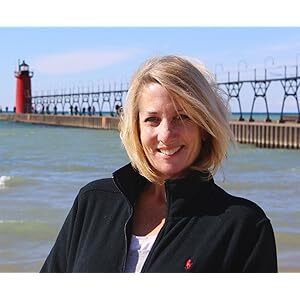 Cozy mystery author, Darci Hannah, is a native of the Midwest and currently lives in a small town in Michigan. Darci is a lifelong lover of the Great Lakes, a natural wonder that inspires many of her stories. When Darci isn’t baking for family and friends, hiking with her furry pals, Ripley and Finn, or concocting her next cozy mystery, she can be found wandering around picturesque lakeside villages with her hubby, sampling baked goods, and breaking for coffee more often than she should.
Cozy mystery author, Darci Hannah, is a native of the Midwest and currently lives in a small town in Michigan. Darci is a lifelong lover of the Great Lakes, a natural wonder that inspires many of her stories. When Darci isn’t baking for family and friends, hiking with her furry pals, Ripley and Finn, or concocting her next cozy mystery, she can be found wandering around picturesque lakeside villages with her hubby, sampling baked goods, and breaking for coffee more often than she should.
Darci’s books include:
MURDER AT THE BEACON BAKESHOP 1st in the Beacon Bakeshop Mystery Series (Kensington 2021), CHERRY SCONES & BROKEN BONES (Midnight Ink 2019), CHERRY PIES & DEADLY LIES (Midnight Ink 2018), THE ANGEL OF BLYTHE HALL (Ballantine Books 2011, 2nd edition by Piffle & Bombast 2016), THE EXILE OF SARA STEVENSON (Ballantine Books 2010)
You can learn more about Darci and her books at www.darcihannah.comElena Hartwell / Elena Taylor

The post A Fatal Feast at Bramsford Manor appeared first on The Mystery of Writing.
August 18, 2024
Running in the Shadows: Author Guest Post
Running in the Shadows, a Lizzie Crane Mystery by Skye Alexander
Author Guest Post + Book & Author InfoRunning in the Shadows
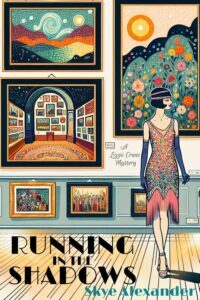 March 1926, Salem, Massachusetts
March 1926, Salem, Massachusetts
A spring equinox party at the mansion of a rich, flamboyant, and controversial art collector promises New York jazz singer Lizzie Crane and her band a fat paycheck, lucrative connections, and plenty of fun. She’ll also have an opportunity to reconnect with a handsome Boston Brahmin she fancies.
But the excitement she hopes for doesn’t turn out the way she expected. On the night of the musicians’ first performance, a naked young woman trots into the ballroom on horseback, sweeps up a talented artist named Sebastian, and rides off with him into the night. The next morning, Lizzie discovers the artist’s body tied to a tree, shot full of arrows like the martyred Saint Sebastian in Botticelli’s painting.
Soon Lizzie learns that her business partner, pianist Sidney Somerset, once had a close relationship with the dead man––and police suspect Sidney of murdering him. As she tries to protect her friend and discover the killer, Lizzie gets entangled in the treacherous underworld of art theft and forgery, a world where fantastic sums of money change hands and where lives are cheap.
To purchase Running in the Shadows, click either of the following links: Amazon & Barnes & NobleAuthor Guest PostClothes Make the Womanby Skye AlexanderThe fashion world is ever-changing, and in the 1920s when my Lizzie Crane mystery series takes place the clothes a woman wore not only expressed her sense of style but also the changing ideas and mores of the Jazz Age. Modern ladies were shedding outdated social roles and restrictions as fast as they cast off their corsets. Hemlines rose to previously shocking lengths, baring ankles and calves. Some daring young women even painted images of their beaus on their knees—their short skirts revealed the pictures when they danced the Charleston.
Glittery flapper dresses, resplendent with sequins and fringe, exposed plenty of skin. On the beaches, swimming costumes crept up high enough that policemen known as “beach censors” trod the sand, measuring ladies’ legs to make sure no more than six inches of flesh showed between hem and knees.
Wearing trousers, too, signaled not only a desire for comfort and convenience, but a shift toward equality between women and men as well. In most circles at that time, a lady dressed in pants raised eyebrows. Some towns in the Midwest and South even outlawed wearing trousers and fined brazen women for doing so.
In the first novel in my Lizzie Crane mystery series, Never Try to Catch a Falling Knife, my jazz singer heroine from Greenwich Village gets off to a rocky start her first day on the job by wearing trousers when she meets her conservative Yankee employer. Sportswomen, however, were grudgingly allowed to don knickers on the golf course or men’s white trousers while playing tennis.
Although off-the-rack pants for ladies weren’t available in the early ’20s, the 1927 Sears catalog offered tweed woolen knickers to golfing girls for $2.98. If you wanted something more in line with what Katherine Hepburn popularized a decade later, you had to have them custom-made or buy men’s and alter them yourself.
The Inside Scoop on Intimate Attire
As women’s outer garments changed, so did their underwear. No longer confined by tight corsets and multiple petticoats, liberated ladies shed the many layers their mothers wore in favor of slinky teddies, camisoles, and bloomers that slid comfortably beneath their slim-fitting dresses. Nylon, polyester, and other synthetic materials didn’t exist at that time, so wealthy women chose undies made of silk whereas ladies of lesser means garbed themselves in cotton, rayon, and wool. Instead of only boring white, lingerie now became available to style-conscious women in pink, peach, beige, light green, and naughty black.
Prior to the Roaring Twenties, women wore thick stockings primarily for warmth. Now, with their legs on display in their new short skirts, modern ladies switched to sheer stockings that showcased their calves. Silk stockings were the preferred choice for those who could afford them at $1.48/pair in 1925 (the equivalent of about $25 in today’s money), in colors ranging from champagne to black. Rayon provided a cheaper alternative for cost-conscious women––and if they objected to the material’s sheen, they dusted their legs with powder to soften it.
Women who still chose to wear girdles clipped their stockings to attached garters. Free-spirited fems rolled their stockings into place and fastened them just above the knee with elastic bands. The bands, sometimes called “jazz garters,” soon became a fashion statement in themselves, decorated with lace, ribbons, and rhinestones in sexy colors such as purple, red, and black. And if a woman wanted to keep a nip nearby in defiance of Prohibition, she could wear a garter flask that featured a pocket with a small silver container to hold her drink of choice.
Shopping for Clothes in the Roaring Twenties
Prior to the 1920s, most women made their own clothes. But as more entered the workforce during the Jazz Age—half of single women were employed outside the home in 1930—they had less time to devote to sewing. In response to this trend, department stores such as Macy’s and Bergdorf Goodman began selling off-the-rack garments. Now, busy ladies could purchase ready-made dresses, coats, and other clothing rather than engage in the time-consuming task of creating their own wardrobes or paying seamstresses to fabricate them.
For people who couldn’t afford to buy at upscale department stores, a shopping alternative arose during the 1920s: thrift shops.
Prior to this time, peddlers hawking used clothing and other goods were common in America’s cities and towns—especially in less affluent neighborhoods. Many of these merchants were Jewish immigrants. But during the twenties, Christian churches began establishing outlets to sell clothing and other products donated by parishioners with the goal of raising money for their churches.
Goodwill trucks collected used clothing from more than a thousand households in the Twenties and proceeds from thrift stores funded half the Salvation Army’s budget. Chanteuse Lizzie Crane, my style-savvy protagonist, realizes that the wealthy ladies for whom she performs wouldn’t be caught dead wearing the same evening gown twice, and she buys most of her attire secondhand at church charity stores.
Hemlines and the Economy
Not only do the clothes a woman wears reveal her personal tastes, social class, and ideology, they may also be an indication of the economy. According to the “Hemline Index,” skirts rise during periods of prosperity and lengthen during leaner times. The short skirts of the Twenties celebrated a post-war boom as well as newfound freedoms for women. During World War II and the recession that followed, women’s hemlines dropped again. When times were good in the 1960s, the fashion world gave us the miniskirt and the bikini.
That’s not to say investors should take tips from haute couture—it’s likely that the fashion industry follows economic trends rather than predicting them. But perhaps something more than personal taste or vanity influences a woman’s choice of clothing. Risqué styles reflect a sense of playfulness, confidence, and freedom from limitations or worries, whereas more serious garb suggests a desire for protection, endurance, and the security of tradition.
Whether or not these psychological connections have any merit, certainly the Roaring Twenties transformed the way women thought of themselves and their place in the world—and their clothes reflected that transformation.
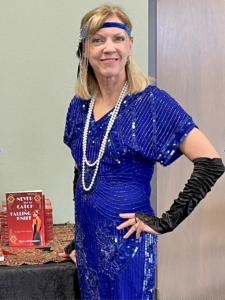 Skye Alexander — Author of Running in the Shadows
Skye Alexander — Author of Running in the Shadows[image error]Skye Alexander is the author of nearly 50 fiction and nonfiction books. Her stories have appeared in anthologies internationally, and her work has been translated into fifteen languages.
In 2003, she cofounded Level Best Books with fellow crime writers Kate Flora and Susan Oleksiw.
So far her Lizzie Crane mystery series includes four traditional historical novels set in the Jazz Age: Never Try to Catch a Falling Knife, What the Walls Know, The Goddess of Shipwrecked Sailors, and Running in the Shadows.
After living in Massachusetts for thirty-one years, Skye now makes her home in Texas.
To learn more about Skye, click on either of the following links: Website & FacebookElena Hartwell / Elena Taylor

The post Running in the Shadows: Author Guest Post appeared first on The Mystery of Writing.
August 13, 2024
I Know She Was There: Cover Reveal
I Know She Was There, new suspense by Jennifer Sadera
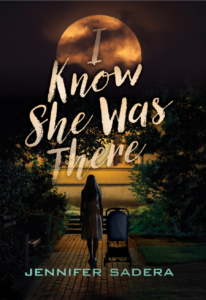 Be careful what you see when you shouldn’t be looking.
Be careful what you see when you shouldn’t be looking.Residents of the posh Upstate New York neighborhood of Deer Crossing enjoy all the amenities wealth provides. From drive-up dog-grooming to monthly botox parties, these lucky suburbanites have everything they could ever want. And one thing they don’t. Stalker Caroline Case, who wheels her infant along their streets each night with just one goal…to spy on anyone too careless or too foolish to close their window blinds.
Convinced the owners of the impressive homes are living a dream existence, the troubled new mom hopes to escape her working-class life by prying secrets from the unsuspecting. But the fairy tale twists into a nightmare when she sees something she shouldn’t. Something that shatters her illusions about the people in the privileged community she’s obsessed with, even as she begins to doubt what she saw.
As Caroline investigates the event, shocking secrets are laid bare, and nothing is as it seems. She knows she must prove something sinister occurred in Deer Crossing or risk letting someone get away with murder.
Genre: Psychological Suspense, Domestic Suspense
Published by: CamCat Books
Publication Date: November 12, 2024
Number of Pages: 352
ISBN: 9780744310955 (ISBN10: 0744310954)
 Jennifer Sadera began her writing career just out of college as a junior copywriter at book publisher NAL before transitioning to the editorial departments of national women’s magazines Woman’s World, Redbook, and Beauty Digest. She’d already established herself as a freelance writer and blogger when she decided to follow her true passion: creating novels.
Jennifer Sadera began her writing career just out of college as a junior copywriter at book publisher NAL before transitioning to the editorial departments of national women’s magazines Woman’s World, Redbook, and Beauty Digest. She’d already established herself as a freelance writer and blogger when she decided to follow her true passion: creating novels.
She is an active member of International Thriller Writers, Mystery Writers of America, and Sisters in Crime; her writing has earned her multiple awards at Atlanta Writers Conferences and a fellowship at the Martha’s Vineyard Institute of Creative Writing. I Know She Was There is Jennifer’s debut psychological suspense novel.
When not writing, Jennifer can be found gardening, traveling, or reading anything she can get her hands on. She is blessed with CJ, her husband of many years, two adult children, Amanda and Ryan, and two adorable rescue grand dogs named Sunny and Moonie.
To learn more about Jennifer, click any of the following links: JenniferSadera.com, Goodreads, Instagram – @jensadera, Twitter/X – @jennifersadera & Facebook – @jennifersadera

The post I Know She Was There: Cover Reveal appeared first on The Mystery of Writing.
August 12, 2024
In the Pale Light: A Crime Thriller
In the Pale Light, a crime thriller by Westley Smith [image error]
Guest Post + an Excerpt + Book & Author Info + a Giveaway!
Don’t miss any blog tour post! Click the link here.
In the Pale Light
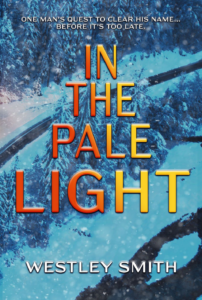
When Clay Graham and his family are found slain in the parking lot of his struggling business, the police suspect Clay’s troublemaker brother, Terry. Terry claims he was drunk the night of the murders and passed out at home. With little evidence against Terry to make an arrest, the case soon goes cold.
Shunned from the community, harassed by the locals who believe he’s a murderer, and suffering from an undiagnosed illness, Terry lives alone on his farm, punishing himself for his past indiscretions.
Then Pennsylvania State Police Trooper Henry Miller, who has ties to the town and the Graham murders, shows up with newly discovered evidence that kick-starts the case all over again.
Now, before his illness kills him, Terry sets out, battling against small-town secrets and old grudges, racing against time to stay one step ahead of both the State Police and his own impending death, to finally find out what really happened to his family and hopefully prove himself and innocent man –if he is one.
Book Details:
Genre: Crime Thriller
Published by: Watertower Hill Publishing
Publication Date: August 13, 2024
To purchase In the Pale Light, click any of the following links: Amazon | Goodreads | Watertower Hill Publishing
Excerpt In the Pale Light:
December 25th, 2015
The emergency lights from the Hickory Falls Sheriff’s Department Ford Interceptor flashed across the snow when it pulled into the Graham Video store parking lot. The sheet of white should have been untouched by tires at 6:45 a.m., and the snow-covered green Jetta, sitting in the far left-hand corner of the parking lot should not have been there. Two different sets of tire tracks cut through the pristine snow. One set belonged to the Jetta. The other set made a large circle in the snow before making its way back toward Main Street.
The officer brought the SUV to a stop about five feet from the Jetta; its headlights bathed the car in the frigid darkness. Unable to see past the Jetta’s frosted snow-covered windows, a building sense of unease began to crawl over him, tightening the flesh to his bones.
The officer’s shift had been easy that night. He had not responded to any emergency calls, nor had he had to pull anyone over. A Christmas miracle itself. But all that had changed fifteen minutes ago while he was patrolling Broke Run Road, when Sheriff Will Daniel’s voice came over the radio.
“Call just came in. We got a report of shots fired at the Graham Video store. Caller says they saw a man running across the parking lot, carrying what appeared to be a shotgun. The suspect reportedly got into the passenger side of a blue sedan before it took off with two others inside. Need you to check it out,” Daniel had said.
Why the hell is the sheriff in at this hour? the officer had wondered. Shouldn’t Susan be on the call desk? And what’s going on at the Graham Video store?
Now on scene, with the first cracks of gray sky beginning to materialize through the night horizon, he radioed back into the station.
“I’m at the Graham Video store. I’ve located a V-dub Jetta. It’s an early 2000s model. No sign of anyone else, including the reported blue sedan. Though there are two sets of tire tracks in the snow, indicating another vehicle was present.” He glanced at the video store’s entrance. There were no broken windows and no ajar door to indicate a robbery had occurred. The place appeared buttoned up tight. “No signs of a break-in, Sheriff. Getting out to inspect the vehicle.”
“Ten-four,” Sheriff Daniel’s voice came back over the line. “Proceed with caution.”
Again, the officer thought it was strange that the sheriff was in at that hour, and on Christmas morning. Where was Susan Green? She usually worked the overnight shift; she should still have been at the station, working the dispatch desk. Still, the officer knew, she could have gone home for any number of reasons—the holiday, the storm, or maybe a family member had fallen –ill—and the sheriff had filled in for her. Pushing the thought from his mind, the officer returned to the pressing matter at hand.
Stay focused. Stay sharp.
Stepping from the SUV, the blowing snow and driving wind bit at the officer’s exposed skin, penetrated his clothes. Zipping his jacket up to his chin, he started toward the car, trudging through the shin-deep snow.
As he neared the Jetta, pelted with snow and ice so hard it stung, he noticed a set of footprints leading away from the passenger-side door toward the second set of tire tracks before vanishing. The tracks were nearly filled in with fresh powder, but it was unmistakable what they were. He assumed this was where the person had gotten into the second car—an old blue sedan. Looking back to the Jetta, he saw something smeared along the top of the passenger-side door. Whatever it was had frozen to a hard, ruby-colored substance.
He eased in for a closer look.
lood!
Frozen blood.
A strange tightness gripped the base of the officer’s neck as if Death had wrapped a cold, boney hand around him and begun to squeeze. His heart rate quickened. He placed his right hand on his sidearm and identified himself.
“This is the Hickory Falls Sheriff’s Department. If there’s anyone inside the vehicle, would you please step out?”
There was no reply. The car was dead still. The only sound across the parking lot was the howling wind and the ice pebbles hitting the closest metal lamp post.
Not wanting to disturb what he believed to be blood on the passenger-side door, the officer lumbered through the deepening snow, around the front of the Jetta, to the driver’s side. Reaching down, he took hold of the handle and pulled.
The driver’s side door was locked.
He took a deep breath of cold air, sending what felt like ice daggers into his lungs as he tried to steel himself for what he might find inside. His teeth began to chatter, and an internal shudder tremored in his core and quickly expanded to the rest of his body.
“I’m asking anyone inside to identify themselves and step out.” He waited, but when no one replied, he said, “If you do not comply, I will be forced to inspect the vehicle. Last warning.”
Silence.
No movement came from within. The car’s stillness bothered him—like it was dead. But that was impossible. Cars could not be deceased like humans or animals. So why was he getting the dreaded feeling that death emanated from it?
Placing his gloved hand on the window, he brushed the light dusting of snow away and bent down to look inside.
The officer recoiled at what he saw or who he saw staring back at him. His feet slipped out from under him, and he went down onto his backside, hard. Snow kicked up when he hit the ground, and for a moment he was cocooned in falling white powder, protected from what he had seen.
But when the snow settled, the officer was again gazing at the driver’s-side door of the Jetta. There, he saw a man’s pale face pressed against the glass, the muscles twisted and tightened in agony. His eyes were open and locked directly on the officer with a vacant, lifeless stare, pleading with him, even in death, to save him.
Too late. I’m too late to save you.
The officer shot to his feet; snow fell off his uniform in large patchy clumps. And though the temperature was in the teens, he felt sweat break out across his back and forehead.
Moving gingerly toward the Jetta again, the officer realized he knew the dead man looking back at him.
Clay Graham—the owner of the Graham Video store.
He removed his Maglite from his belt and turned it on. Bending, he shone the beam through the ice-crusted driver’s-side window and began to scan the car’s interior.
That’s when he saw them.
He pressed a gloved hand over his lips, suppressing the scream that wanted to leap from his throat at the horrific sight of carnage and death inside the Jetta.
It wasn’t just Clay Graham dead inside the car but also his wife, Claire, and their teenage daughter, Sidney.
***
Excerpt from In the Pale Light by Westley Smith. Copyright 2024 by Westley Smith. Reproduced with permission from Westley Smith. All rights reserved.
Guest Post from Westley Smith — Author of In the Pale Light
Writing and Health
In my latest crime thriller, In The Pale Light, the main character, Terry Graham, suffers from an undiagnosed illness throughout the book—he’s a dead man walking. While I was writing this book, I was going through some health scares that I couldn’t identify, just like Terry was. That got me thinking about how important your health (physical and mental) is and that it can’t take a back seat, even when you’re working your dream job.
I spent most of my life working in steel factories (hot in the summer, ice cold in the winter) before I hit the lottery and was able to publish my first manuscript, Some Kind of Truth. I use the term lottery because that’s what it felt like when I got the acceptance letter. I’ve been writing since I was ten years old and have been submitting work to various magazines, agents, and publishers since I was in my twenties without much success.
It was a grind to write every day and constantly get rejected by everyone, including those closest to me who wanted me just to follow the status quo. Sure, I could have made a good living working in a factory, slinging steel in the heat and cold, but it wasn’t what I wanted to do. It wasn’t what I was born to do. Dealing with all of this was mentally and, oftentimes, physically draining. But I persisted. I pushed through. I sacrificed time spent with friends and family to pursue my dream. If I didn’t believe in me, then no one else would.
For the first time in my life, during the pandemic in 2020, I could solely focus on my writing. The world was closed, and things were bad (as I’m sure most of you remember), but it allowed me to commit to my writing full-time and really hone my craft.
But as I spent hours and hours sitting at the computer, writing and rewriting that first manuscript, which would be published in February of 2024, I started feeling this strange pain in my abdomen that I couldn’t explain.
For most of my life, I have been an active person – I played sports as a kid, I weight lift as an adult, I hike, I work around my house, and let’s not forget I used to sling steel for eight to ten (sometimes twelve) hours a day, so I was used to moving all the time. This was the first time in my life that I had a sit-down job, and being that it was 2020, there was nothing else to do since, at the time, we didn’t know how contagious the virus was.
So, this pain in my abdomen worsens throughout 2020 and into 2021. And as you can imagine, all kinds of thoughts are going through my head (just like they go through Terry’s in the book). Do I have a bowel blockage, a perforation in my intestinal lining … or, good God, could it be cancer?
I hadn’t been doing anything normal, as I suspect most people weren’t living their everyday lives during this time. I was sitting more than I ever had, writing, reading, watching the news from Washington, worrying if we as a species would survive. In those dark days, I gained weight, and this pain wasn’t going away. So I decided to get up and walk for ten minutes for every hour I worked. Because, indeed, the lack of movement was causing this pain in my abdomen, right? Right?
Wrong.
Moving into 2022, and still with this abnormal pain (that my doctor can’t figure out), I’m miserable. I’m worried. I’m afraid. I don’t know what’s causing it or why it’s there.
And then, one night, it all became clear.
My wife had brought home some ice cream from our favorite ice cream shop. During that week, I didn’t have much discomfort in my abdomen, and I was starting to think that whatever was bothering me might be due to stress (since the world was in chaos) or, as I said, lack of movement – I had become laser-focused on moving around by this point during the day. So, that evening, I treated myself to a dish of ice cream.
BAM! The pain was back within a matter of hours, and I was miserable once again.
That’s when I realized I had become lactose intolerant. But it wasn’t the only health issue I was facing around that time while pursuing my dream job. Because I had gained weight sitting around in 2020-21, my blood pressure rose sky-high, resulting in blood pressure pills, and I developed a mild (thank God) case of sleep apnea.
From that moment on, I drastically changed everything. I made eating healthy, keeping my weight in check, and training daily/moving a priority like it had always been before my days spent working at a computer. I lost thirty-five pounds and don’t have to use a sleep apnea machine at night because I made these changes.
I had forgotten to care for myself in pursuit of my dream. Don’t let that happen to you. Writing is a lonely job. It is a consuming job. You need to take a break, walk away, get out of your head, and get back into the real world and move.
In the Pale Light Author Westley Smith
 Westley Smith had his first short story, Off to War, published when he was just sixteen.
Westley Smith had his first short story, Off to War, published when he was just sixteen.
He is, more recently, the author of two horror novels, Along Came the Tricksters and All Hallows Eve, as well as the thriller Some Kind of Truth. His short fiction has been published in various magazines and websites.
Wes lives with his wife and two dogs in the beautiful woodlands of southern Pennsylvania–the perfect place to hide a body.
To learn more about Westley, click any of the following links: WestleySmithBooks.com Goodreads BookBub – @wssmith100 Instagram – @wsmithbooks Facebook – @westleysmith100
Visit all the Stops on the Tour!
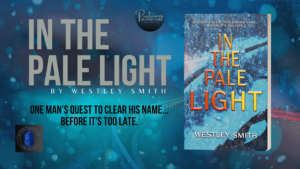
08/12 Guest post @ The Mystery of Writing
08/12 Showcase @ Silvers Reviews
08/13 Interview @ Literary Gold
08/13 Showcase @ Books, Ramblings, and Tea
08/14 Review @ leannebookstagram
08/15 Review @ Avonna Loves Genres
08/17 Review @ Guatemala Paula Loves to Read
08/18 Showcase @ Mystery, Thrillers, and Suspense
08/19 Review @ Country Mamas With Kids
08/20 Review @ Elicias Book Haven
08/20 Showcase @ Celticladys Reviews
08/23 Review @ Melissa As Blog
08/27 Interview @ Cozy Up With Kathy
08/29 Book Talk with Fran Lewis Radio Interview
08/29 Review @ Pat Fayo reviews
08/30 Review @ Cozy Up With Kathy
09/03 Review @ bookwormbecky1969
09/04 Partners in Crime Presents: Author Interview
Elena Hartwell/Elena Taylor

The post In the Pale Light: A Crime Thriller appeared first on The Mystery of Writing.
August 9, 2024
Peach Tea Smash, A Tea Shop Mystery
Peach Tea Smash, A Tea Shop Mystery

Peach Tea Smash

Murder at an Alice in Wonderland–themed event threatens to send Theodosia Browning through the looking glass in the latest entry in this New York Times bestselling series.
During the Mad Hatter Masquerade, a fundraiser hosted by the Friends of the Opera on the grounds of the old Pendleton Grist Mill, Harlan Sadler, husband of Cricket Sadler, the chairwoman, is killed. He’s been hit in the head with a croquet mallet, and his body hung on the chains and paddles of the grist mill. Nobody can figure out why since Harlan was much beloved by everyone.
It’s only after Cricket and Delaine beg Theodosia to investigate that she realizes the killer might have mistaken Harlan for his crazy son, Duke. After all, Duke is a slum landlord and recently injured a woman in a boating accident.
INCLUDES DELICIOUS RECIPES AND TEA TIME TIPS!
Book Details
Peach Tea Smash (A Tea Shop Mystery)
Cozy Mystery
28th in Series
Setting – South Carolina
Publisher : Berkley (August 6, 2024)
Hardcover : 320 pages
ISBN-10 : 0593201019
ISBN-13 : 978-0593201015
Digital ASIN : B0CLKSY4GV
Audiobook ASIN B0CVLG7ZGL
[image error]
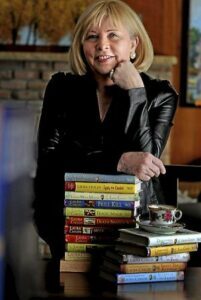
Laura Childs is the New York Times bestselling author of the Tea Shop Mysteries, Scrapbook Mysteries, and Cackleberry Club Mysteries. In her previous life she was CEO/Creative Director of her own marketing firm and authored several screenplays. She is married to a professor of Chinese art history, loves to travel, rides horses, enjoys fundraising for various non-profits, and has two Chinese Shar-Pei dogs.
Laura specializes in cozy mysteries that have the pace of a thriller (a thrillzy!) Her three series are:
The Tea Shop Mysteries – set in the historic district of Charleston and featuring Theodosia Browning, owner of the Indigo Tea Shop. Theodosia is a savvy entrepreneur, and pet mom to service dog Earl Grey. She’s also an intelligent, focused amateur sleuth who doesn’t rely on coincidences or inept police work to solve crimes. This charming series is highly atmospheric and rife with the history and mystery that is Charleston.
The Scrapbooking Mysteries – a slightly edgier series that takes place in New Orleans. The main character, Carmela, owns Memory Mine scrapbooking shop in the French Quarter and is forever getting into trouble with her friend, Ava, who owns the Juju Voodoo shop. New Orleans’ spooky above-ground cemeteries, jazz clubs, bayous, and Mardi Gras madness make their presence known here!
The Cackleberry Club Mysteries – set in Kindred, a fictional town in the Midwest. In a rehabbed Spur station, Suzanne, Toni, and Petra, three semi-desperate, forty-plus women have launched the Cackleberry Club. Eggs are the morning specialty here and this cozy cafe even offers a book nook and yarn shop. Business is good but murder could lead to the cafe’s undoing! This series offers recipes, knitting, cake decorating, and a dash of spirituality.
To learn more about Laura, click on any of the following links: Website – FacebookVisit all the Stops on the Tour!

August 6 – The Plain-Spoken Pen – REVIEW
August 6 – Maureen’s Musings – SPOTLIGHT
August 6 – story.book.lady – REVIEW
August 7 – Mystery, Thrillers, and Suspense – SPOTLIGHT
August 7 – Books, Ramblings, and Tea – SPOTLIGHT
August 8 – Socrates Book Reviews – SPOTLIGHT
August 8 – Lady Hawkeye – SPOTLIGHT
August 9 – Cozy Up With Kathy – REVIEW
August 9 – The Mystery of Writing – SPOTLIGHT
August 10 – Reading Is My SuperPower – AUTHOR GUST POST
August 10 – Paranormal and Romantic Suspense Reviews – SPOTLIGHT
August 11 – FUONLYKNEW – SPOTLIGHT
August 12 – Literary Gold – SPOTLIGHT
August 12 – Mystery Thrillers and Romantic Suspense Reviews – SPOTLIGHT
August 13 – The Avid Reader – REVIEW
August 13 – Celticlady’s Reviews – SPOTLIGHT
August 14 – Escape With Dollycas Into A Good Book – REVIEW
August 14 – Ruff Drafts – AUTHOR GUEST POST
August 15 – Christy’s Cozy Corners – AUTHOR INTERVIEW
August 15 – Sapphyria’s Book Reviews – SPOTLIGHT
August 16 – Baroness Book Trove – REVIEW
August 16 – Ascroft, eh? – AUTHOR INTERVIEW
August 17 – Elizabeth McKenna – Author – SPOTLIGHT
August 17 – StoreyBook Reviews – SPOTLIGHT
August 18 – Sarah Can’t Stop Reading Books – REVIEW
August 19 – Angel’s Book Nook – SPOTLIGHT
Elena Taylor/Elena Hartwell

The post Peach Tea Smash, A Tea Shop Mystery appeared first on The Mystery of Writing.
August 7, 2024
Death in St. George’s: A New Mystery
Death in St. George’s, The Intrepid Traveler Mystery Series by M.A. Monnin[image error]
Guest Post + Excerpt + Book & Author Info + Giveaway!
Don’t miss any blog tour post! Click the link here.
Death in St. George’s

When Stefanie and Thomas meet in Bermuda for time alone away from the demands of the Artifact Retrieval Team that Thomas heads, their romantic rendezvous is waylaid after an archaeologist requests their help to recover an emerald bracelet that’s been stolen from his site.
Thomas is reluctant, but Stefanie can’t resist the lure of buried Spanish treasure. Then one of the archaeologists is murdered, and they find themselves on the suspect list. Spanish gold isn’t the only thing uncovered. Secrets can be deadly, and Stefanie and Thomas must find the killer before it’s too late.
Book Details:Genre: Traditional Mystery
Published by: Level Best Books
Publication Date: May 14, 2024
Number of Pages: 264
ISBN: 9781685126483 (ISBN10: 1685126480)
Series: An Intrepid Traveler Mystery Series, Book 3
To purchase your copy of Death in St. George’s, click any of the following links: Amazon | Barnes & Noble | BookShop.org | Goodreads
Read an excerpt of Death in St. George’s:
DEATH IN ST. GEORGE’S by M. A. Monnin
CHAPTER 1
“I don’t believe you’re the kind of woman who craves peace and quiet,” Thomas said, holding Stefanie’s hand in the back seat of the taxi.
His handsome face melted her heart yet again. She drank in the welcome sight of him, from the strong jaw beneath the stubble of a beard to his chestnut brown hair. The sun-bleached streaks she’d teased him about in Greece would return after a week in Bermuda, she’d bet.
Having arrived in Bermuda earlier in the day, she’d met him at the airport, and they were on the way to rent a car in the Town of St. George.
“A week alone sounds blissful to me,” she countered. “No trying to discover who ran us off the road in Crete or chasing after Borgia Peacocks in Venice.” And no former girlfriends, she thought. But she’d learned enough to not say that aloud. “No calls from René.”
“René knows that I am not taking his calls for a full week,” Thomas said.
René Renault, his boss, and therefore ultimately hers at Interpol’s Cultural Heritage division, didn’t willingly recognize personal time. Thomas, as the head of Interpol’s Artifact Retrieval Team—ART for short—could dictate his own projects. So far their time together had been a non-stop whirlwind of undercover investigation in an effort to reclaim stolen objects that had been reported to Interpol. A little downtime was in order.
“We could lock our cell phones in our suitcases until next Monday,” she suggested.
He smiled. “Is that really what you want?”
What she really wanted was to decide on their future living situation.
There was no question that they would be together. But would she move in with him at his place in Munich? Or keep her apartment in St. Louis and fly to Europe when she couldn’t bear to be apart from him any longer? Asking so soon might go to his head, and she couldn’t have that.
The taxi driver took a sharp curve a little too fast, then swung in to avoid a red scooter speeding from the opposite direction whose driver drove as though both lanes were his.
Stefanie shared a smile with Thomas as they listed from one side to the other with the motion of the taxi.
“I suppose we need the phones to look up places to explore,” she said. “And
I need photos for my travel blog.”
That reminded her to take in the sights, something other than Thomas.
She tore her gaze away from him, but kept her hand in his. The streets of St. George’s were narrow, barely wide enough for two lanes, and in some places, not even wide enough for that. Low garden walls butted right up against the road. Sidewalks, where they existed at all, fit snugly between the road and the series of one- and two-storied houses.
Most of the houses were small and compact, as if hunkered down for impending storms.
“These buildings have been here since the 1690s or early 1700s,” she said, charmed by their low profiles and the wooden shutters that adorned nearly every structure.
In no time at all, the taxi driver pulled up to the car rental.
As he paid the driver, Thomas’s face blanked in disbelief at the tiny electric cars lined up for rent.
“The bigger cars must be in back,” he said, taking his black leather bag, his only piece of luggage, out of the open Ford trunk.
The taxi driver grinned. “Not in Bermuda. It’s the law. Tourists can only rent scooters or electric cars.” Still grinning, he gave Thomas a business card. “Call me if you want me to take you anywhere.”
When Thomas’s gaze brightened on the row of scooters, Stefanie protested.
“No scooters,” she insisted. “I’ve seen how people drive here. Driving on the left will be challenging enough.”
“No problem,” Thomas said. “I’ve driven in England.”
He bypassed the Twizy models, which had a single seat in front and a single seat in back.
“I want you at my side,” he said. “Not behind me.” “Or you behind me,” she countered.
His mouth quirked up. “That would not happen.”
Oh, how she missed the little games they played. It had only been a week since they’d parted at the Milan airport, but those seven days felt like a year.
After inspecting several small, square Italian Tazzaris, which had two front seats, Thomas grudgingly chose one in red.
“I didn’t think I’d be driving a toy car,” he said as they folded themselves into the Tazzari.
She laughed. “Admit it, you’ve always wanted a red Italian car.” She buckled her seatbelt with difficulty due to his leather duffle on her lap, which was too large to cram into the minuscule storage space behind their seats.
Resting her arms across the duffle, she entered their address into the GPS on her phone. “We’re lucky Greg wasn’t using his house this week. A whole house to ourselves is so much nicer than even the best hotel.”
Her former bank client, Greg Edwards, had often urged her to stay at the house whenever she wanted. Greg, the dedicated owner of Riverboat Rum based in St. Louis, only made it to Bermuda occasionally. Usually when corporate finances and Bermudian law dictated. The bungalow stood on a cliff on the outskirts of the historic Town of St. George. Painted peach, the two-bedroom cottage had an intimate covered patio at the rear that faced the glassy Atlantic—a perfect place to write her travel blog and enjoy the sun.
Thomas’s claim about driving on the left was justified. He had no problem acclimating, and in short order, they’d gone the less than a mile to Greg’s house.
After changing into swimsuits to lounge in the warm Bermuda sunshine, Thomas poured them each a glass of pinot grigio, and they settled onto the chaise lounges in the backyard.
The smoky scent of a neighbor’s wood fire mixed pleasantly with the tang
of sea air. Stefanie glanced around the yard and patio for a fire pit they could use but didn’t see one.
“Bermuda is more colorful than I expected.” Thomas’s gaze went from the low wall painted to match the peach house color to the neighboring bright blue cottage beyond, with its white stepped stone roof. He shifted his gaze from the neighbor’s house to her. “The view is stunning.”
She smiled and set her wine on the small metal table between them.
“Just you and me,” Thomas said. “Alone.”
“Alone,” she agreed. “With our peace and quiet. But you never know,” she teased, “maybe it was the adventure that drew us together.”
Swinging his legs off the chaise lounge, he sat up with his feet planted firmly in the grass and took her hand. “Is that all?”
No, but Thomas found the excitement of the chase irresistible. She smiled as he massaged her palm with his thumb, but didn’t move closer to make it easier for him. Keeping him on his toes was delightfully entertaining, something that he enjoyed as much as she did.
“Where should we go tomorrow? A boat tour to spot sea turtles?” she asked.
Still holding her hand, he said, “Let’s go snorkeling. Tobacco Bay. The fish and coral there are supposed to be worth seeing.”
“I’ve never been snorkeling,” she admitted. “I planned to try it in Crete, but there wasn’t time. Have you?”
“At the Great Barrier Reef.”
Australia. That didn’t surprise her. As the son of the owner of Germany’s largest publishing firm, he’d probably gone all over the world and done all kinds of activities that she’d never tried. Never tried because she’d dedicated all her time to working at Markham-Briggs Bank. That wasn’t happening anymore.
“There’s nothing to it,” Thomas said. “You’ll love it. And after we’ve done Tobacco Bay, we’ll snorkel above shipwrecks. Bermuda is surrounded by them. Until then,” he said, “I want you all to myself.”
She gave in and swung around to a sitting position facing him. Bending forward, she lifted her lips toward his, stopping a breath away. “You have me.”
A discreet throat-clearing intruded on their moment. It came from the direction of the blue house next door. Reluctantly, Stefanie pulled back.
On the other side of the peach-colored wall, a thin man of about five foot eight or nine, tanned and with receding blond hair, peered at them from between two large palm trees. He’d changed from the sweat-stained blue polo and dusty dark grey knee-length shorts he’d worn when she’d met him two hours before and was dressed as colorfully as the houses in a pastel plaid shirt above coral Bermuda shorts.
Stefanie hid her disappointment. “It’s Jeffrey Fitzsimmons,” she said in a low voice. “I picked up the keys from him when I got here this afternoon.”
She scooted further back on the chaise lounge and slipped her arms through her linen cover-up. Chatting with neighbors while dressed only in a skimpy bikini put her at a disadvantage.
“Good afternoon,” Jeffrey called to them. “Sorry, don’t mean to interrupt.” Thomas observed him without replying.
“Good afternoon,” Stefanie called back as she stood up. Greg had cautioned her about always including a polite greeting when she visited Bermuda. “The locals are sticklers about common courtesy,” she told Thomas. “We’ll be outcasts if we forget that.”
“Always the customer service vice president,” he remarked.
“If I’d gotten that promotion,” she said, “we never would have met.”
He leaned in and kissed her. “A tragedy averted.”
She smiled, then glanced at the neighbor. “Jeffrey’s the kind who likes to talk. I had to make excuses so I could meet you at the airport in time. Luckily, the taxi was waiting.” She gave Thomas’s bicep a gentle squeeze. “We don’t want to get on his bad side. We might want to use this house as a getaway again.”
“Neutral territory?” he asked. “Conveniently located between the U.S. and Europe?”
“Something like that,” she said, then turned back to Jeffrey.
The neighbor indicated the wall that separated the properties. “May I?”
“Yes, of course,” Stefanie answered.
Jeffrey stepped over the wall. He’d come prepared, bringing his own bottle of beer.
There were only two chaise lounges, but two metal chairs at a small table against the house were available. Stefanie gestured toward them.
She and Thomas dragged their lounges around to face the patio rather than the ocean.
“Welcome to Bermuda,” Jeffrey said to Thomas.
Thomas must have worried that the neighbor was settling in for an evening of conversation.
“Thank you,” he replied. “We’ll be trying your local cuisine at dinner soon.”
“Here on St. George’s Island? I can recommend places,” Jeffrey offered as he pulled out a pink metal chair. “The Wahoo Bistro has fantastic fish.”
“Hamilton,” Thomas said, mentioning Bermuda’s capital city on the main island.
Jeffrey nodded. “More nightlife there.”
Thomas pointed a finger at Stefanie’s empty wine glass. “Another?”
“Yes, please.” She turned back to the neighbor. “Do you live here yearround, or part-time, like Greg?”
“Year round,” Jeffrey said. “I’m with the National Museum of Bermuda.
The lead archaeologist.”
“Are you?” She perked up. “Thomas has a degree in archaeology, and I once interned at a dig on Crete. I didn’t go into archaeology as a career, though.”
“Oh, I know you’re in banking,” Jeffrey said. “Greg’s told me all about you.”
Thomas caught that last piece of info as he returned with the half-empty bottle of pinot grigio.
“Has he?” Thomas asked, filling Stefanie’s glass.
She was surprised at that news, too, but didn’t clarify that she wasn’t in banking anymore. Her work with ART was confidential.
“Yes.” Jeffrey turned back to Stefanie. “Greg told me about your involvement with the Akrotiri Snake Goddess in Greece.”
Stefanie and Thomas exchanged glances. She hadn’t mentioned her part in it to any of her former colleagues at Markham-Briggs. In fact, other than those directly involved, she hadn’t even talked to anyone about the theft of the Akrotiri Snake Goddess. That had been left to the news media and whatever details the Greek police gave out. Thomas never boasted about his accomplishments. It was counterproductive to future cases.
“Jeffrey’s an archaeologist here in Bermuda,” she told Thomas.
The neighbor leaned forward, beer bottle in hand, elbows on knobby knees. “I’m hoping you can help me.”
So he’d had something specific in mind when she brushed him off to get to the airport.
With that news, Thomas seemed even less receptive to the intrusion. He concentrated on pouring wine into his own glass. “Yes?”
Jeffrey gave him a brief smile but focused on Stefanie. “It’s your help I want.”
Stefanie and Thomas exchanged another look, one of surprise that time and amusement. Thomas had put in the major investigative work in their endeavors. She’d simply used the customer service skills she’d learned at Markham-Briggs Bank to her advantage. Yet Jeffrey approached them because of her reputation, rather than Thomas’s stellar career. One point to her.
His eyes bright with humor, Thomas lowered himself onto the chaise lounge. Sipping his wine, he let her have the spotlight.
“My help?” Stefanie asked. “I’m not in banking anymore.”
“Greg says you’re known for your discretion.” Jeffrey leaned even further towards them, sitting on the edge of his seat. “And from your time at the bank, that you have an eye for potential trouble.”
You never knew what people would remember. She’d entertained Greg once with a description of what she noted about each person when they entered the bank, watching for signs of potential robbery.
Thomas’s grey-blue eyes sharpened.
“Something has disappeared from the site I’m working on.” Jeffrey spoke in hushed tones despite the fact that they were in the backyard, with the Atlantic on one side and empty yards on the others. “The theft hasn’t been reported yet, and we—I,” he emphasized, “hope it can be recovered before anyone has to know that it’s missing.”
She peered at Jeffrey. He’d gotten awfully close to their actual jobs. Disconcertingly close. “I’m not sure how discretion and an eye for potential trouble will help after the fact,” she said.
Thomas was leery, too. “Why didn’t you report the theft?”
“The homeowners didn’t want the publicity if it could be avoided. I went along with that to protect our reputations.” Jeffrey’s gaze darted between Stefanie and Thomas. “If we don’t get it back, our professional reputations are shot. Each one of us working the site.” “What kind of site?” Thomas asked.
“It’s on privately owned land. There’s a garden renovation going on at Carmichael House here on St. George’s,” Jefferey said. “The owner, Marlene Carmichael, our Minister of Economy and Labor, wants to make it a showplace. When a dead tree in the existing garden was removed, a small chest was exposed under the roots. That prompted a call for an archaeological assessment of the area to see if anything else was buried in the vicinity.”
“A chest?” Stefanie asked, giddy as a child with an unwrapped present as she pictured a metal-strapped wooden treasure chest filled with gold and jewels.
Jeffrey held his hands about ten inches apart. “A small one. Brass and steel.”
She cocked her head. “What was in it?”
A short laugh escaped Jeffrey’s lips. “Nothing.”
Thomas raised his eyebrows at that. “Any idea how it ended up here?” Jeffrey sat back. “Most likely a Spanish shipwreck in the mid to late 1500s. Spanish and Portuguese sailors occasionally washed up on Bermuda before the Sea Venture wrecked in 1609 and we British settled here. We believe the ship this chest came from was on its way from Cartagena to Spain.”
An exciting find. But the chest was empty. That was disappointing. And now it was missing. Having a reputation for discretion was nice, but the investigation should be carried out by the authorities, not two vacationers with few resources.
“I’m a travel blogger now, and Thomas is an assistant professor of archaeology,” she said, using their completely legitimate cover occupations.
“What you’re describing sounds like a job for the police.” Thomas agreed.
Jeffrey’s brows drew together, disappointment written in every line of his features. “We can’t have another Tucker’s Cross. We can’t.”
A spark of excitement flickered deep within Stefanie’s chest. She’d read the story of Tucker’s Cross in the guidebook she’d brought on the flight from the States.
“The emerald and gold cross that was recovered from the San Pedro,” she said. “Replaced with a forgery, which was discovered just in time for Queen Elizabeth’s visit in 1975.”
Thomas set his wine glass on the table. “Stolen.”
“When the archaeological record gets lost, the whole island loses. It can’t happen again,” Jeffrey said, his voice rising in desperation. “It can’t.”
Surely that emotion on his face wasn’t for a small brass chest, even one that was 450 years old.
Thomas’s eyes narrowed. “It isn’t the chest that’s missing, is it?”
Guest Post by by M. A. Monnin — Author of Death in St. George’s
AVOCATIONAL ARCHAEOLOGY
One of the best things about being a writer is that I get to share my interests with readers. In Death in St. George’s, that interest is archaeology. Don’t get me wrong—I’m not a professional archaeologist. I’m an avocational archaeologist. As I like to put it, that means I can take direction from a professional. If they’ll let me. My instruction has come from archaeologists during different projects conducted by the Kansas City Archaeological Society.
I’ve been fascinated by archaeology ever since I picked up a copy of Howard Carter’s book The Discovery of the Tomb of Tutankhamun in my base library decades ago, and have employed that fascination in my Intrepid Traveler Mystery series. My intrepid sleuth Stefanie Adams once interned at a dig on Crete, and Thomas Burkhardt holds degrees in archaeology, though an incident in his early life made him choose police work over archaeology. There are hints of that in Death in St. George’s, and both Stefanie and Thomas get to indulge their interest when a neighbor asks them to help him find an artifact that’s gone missing from the archaeological site he’s working on.
The site in St. George’s is a small one—a chest, and more, have been found buried during a garden renovation. The small scope of that excavation might surprise you, but often, archaeological sites are small, unlike what you’ll find in Egypt, Greece, and China for example. Artifacts can be decades or hundreds of years old, rather than thousands of years, like you’ll see on popular programs on Discovery Channel. But they all add to our knowledge of history, and they all use the same basic techniques, no matter the size or age of the site. The characters in St. George’s lay out their squares and sift carefully through the soil in much the same way that professionals at Saqqara or Delphi do. They use the same basic tools: trowels, buckets, tape measures, and screening frames.
My own finds have been less than stellar, usually window glass or early nails, and once a pretty teal-colored bottle. One year I participated in a Project Archaeology dig at Fort Osage, Missouri, a fort high above the Missouri River. I found a button, white with a flower pattern on it and was quite excited, thinking it was originally sold at the trading post, only to have the professionals tell me that it was probably a re-enactor’s button from the 1970s. Either way, I logged it with location and date, and into the paper bag it went, part of the permanent record.
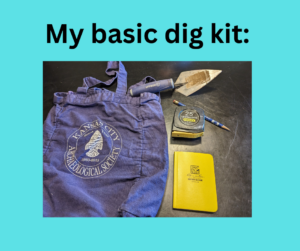
A huge part of an archaeological dig is doing the research beforehand. What records exist to show the occupation of a site? Are they complete? When I decided to place my third book in Bermuda, I hoped to visit a current excavation. A team from the US had been conducting a dig on one of the islands, but unfortunately, they didn’t have a field school the year I went. Quite happily, though, the team had a blog about the site, and I read the entries and poured over the photos both before I visited Bermuda and after I came back. Archaeologists at the National Museum of Bermuda were an enormous help, answering my questions and even giving suggestions. In fact, I included butteries in my book after learning from one of the archaeologists how common they were in Bermuda. A small stone building isolated in the back of a property? Yes, please.
Mystery novels and archaeology have a lot in common. Both involve searching through an accumulation of material for treasure, whether that treasure is a clue or an emerald bracelet. The excitement of a find gets your heart racing and fires your imagination. Both require focused thought and attention to detail to discern the real from the reproduction, the clue from the red herring.
Happy hunting!
M.A. Monnin — Author of Death in St. George’s
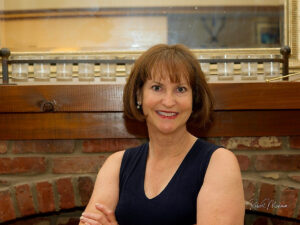 M. A. Monnin is the author of the Intrepid Traveler Mystery series, including Agatha Best First Novel finalist DEATH IN THE AEGEAN. Her 3rd in the series, DEATH IN ST. GEORGE’S, came out May 2024. She also writes the St. Killian, PI and the Hawk Hathaway, Time Traveling Troubleshooter short stories.
M. A. Monnin is the author of the Intrepid Traveler Mystery series, including Agatha Best First Novel finalist DEATH IN THE AEGEAN. Her 3rd in the series, DEATH IN ST. GEORGE’S, came out May 2024. She also writes the St. Killian, PI and the Hawk Hathaway, Time Traveling Troubleshooter short stories.
Mary’s short stories have appeared in Black Cat Mystery Magazine, Black Cat Weekly, and numerous anthologies. A member of ITW, MWA, SinC, and SMFS, an avocational archaeologist and USAF veteran, Mary is a trustee of the Kansas City Archaeological Society and treasurer of Mid-America Romance Authors. She lives in Kansas City, MO.
Learn more about M. A. by clicking any of the following links: www.mamonnin.com, www.CuratorsofCrime.com, Goodreads, BookBub – @monninma, Instagram – @m.a.monnin, Twitter/X – @mamonnin1 & Facebook – @MAMonnin
Visit all the Stops on the Tour!
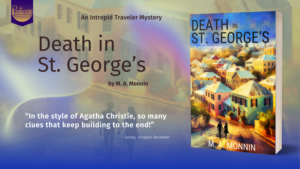
07/29 Showcase @ Books, Ramblings, and Tea
07/30 Interview @ Literary Gold
08/01 Interview @ darciahelle
08/01 Review @ Country Mamas With Kids
08/02 Review @ FullyBookedInKentucky
08/02 Showcase @ fuonlyknew
08/03 Guest post @ Guatemala Paula Loves to Read
08/05 Showcase @ Mystery, Thrillers, and Suspense
08/06 Review @ Its All About the Book
08/07 Guest post @ The Mystery of Writing
08/08 Review @ Book Reviews From an Avid Reader
08/09 Review @ Book Corner News & Reviews
08/10 Showcase @ Binge Reading Books
08/15 Showcase @ Celticladys Reviews
08/16 Showcase @ Silvers Reviews
08/19 Review @ Nanas Book Reviews
08/22 Review @ reviewsbyrudra
08/23 Review @ The Book Connection
Elena Taylor/Elena Hartwell

The post Death in St. George’s: A New Mystery appeared first on The Mystery of Writing.

